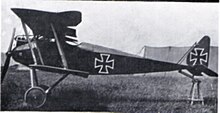|
Jagdstaffel 22
Royal Saxon Jagdstaffel 22 was a "hunting group" (i.e., fighter squadron) of the Luftstreitkräfte, the air arm of the Imperial German Army during World War I. As one of the original German fighter squadrons, the unit would score 57 verified aerial victories. Their eleven wins over enemy observation balloons made them a balloon buster squadron.[1] In turn, their casualties for the war would amount to five pilots killed in action, four killed in midair crashes, one killed in another flying accident, two wounded in action, and two taken prisoner of war.[1]  HistoryRoyal Saxon Jagdstaffel 22 was authorized on 25 October 1916; it formed on 16 November 1916. Its genesis was in the 7 Armee area, and its original personnel came from two field flier detachments, FF(A) 11 and FF(A) 29, and an artillery cooperation unit, FA(A) 222. It mobilized on 1 December 1916. First victory for the new unit is debatable; Leutnant Gustav Rose posted a claim for 27 December 1916, but Josef Jacobs was credited with downing a Caudron on 23 January 1917. Jasta 22 would serve through war's end and beyond; the squadron would not disband until 1919, in Marburg.[2] Commanding officers (Staffelführer)
Aerodromes
Notable members
AircraftOriginal equipment at mobilization was nine Halberstadt D.II and two Albatros D.II fighters. The Jasta operated Albatros fighters until it gained Fokker D.VIIs in 1918.[2] It had at least one Siemens-Schuckert D.IV during the closing days of the war, as Staffelführer Lenz used one to become an ace on 29 September 1918, and was delighted with the aircraft.[8] Operations Jasta 22 was originally formed in the 7 Armee area. It is known to have supported that army until well into 1917. Jasta 22 fought until war's end, and disbanded in 1919.[2] References
|
||||||||||||